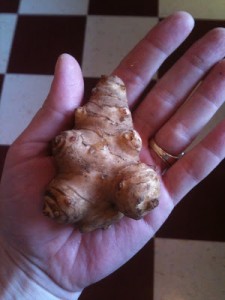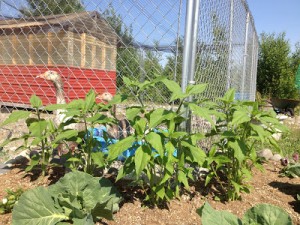For those of you who don’t know, a Sunchoke, or Jerusalem Artichoke, is a perennial related to the sunflower with a tuberous root that is very edible and quite tasty. I have been hearing about Sunchokes and their cold temperature hardiness for many years now, and they seem like a great perennial vegetable for Alaska, yet I’ve never seen them planted in the gardens around here.
Known for their pretty flowers as well as their plump roots, they seemed like the perfect fit for my permaculture aspirations! I finally found them in the produce section of our local grocery store last fall, and I have been looking forward to testing out their potential all winter!
The package came with 10 roots, and I experimented with cooking 4 of them, using them raw in salads or roasted like a potato with a little olive oil. The remaining 6 were wrapped in plastic wrap and put in the back of the refrigerator crisper drawer, where they remained until the end of May.
This spring, when the ground was ready to be worked, I simply opened the package up and let it sit on the counter for a few days, and then planted them about a foot apart and 6-8 inches down into the soil. I made sure to select an area where they can fill up the space over the years without bothering anything else in the garden.
They sprouted out of the ground within about two weeks, and a month later, they are growing beautifully and providing a shaded area for my geese as well! They seem to be very tolerant of the heat we have been having, and don’t seem to be bothered by any pests so far.
We’ll see how they do as the season progresses, and hopefully they will become a permanent resident in the garden!
Jamie shares her thoughts and ideas as she explores organic gardening and permaculture in Big Lake, Alaska. She writes about chemical-free gardening in a cooler climate, saving energy or using alternatives, cooking from scratch, and living a more frugal lifestyle.
susitnafarm.blogspot.com






